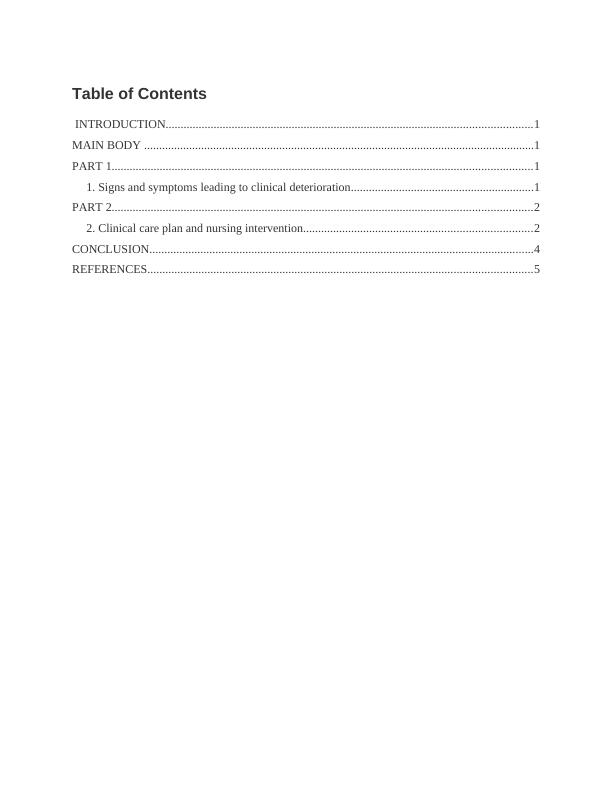(solved) Pathophysiology Assignment
12 Pages2915 Words458 Views
Added on 2020-11-12
(solved) Pathophysiology Assignment
Added on 2020-11-12
ShareRelated Documents
SEPTIC SHOCK

Table of ContentsINTRODUCTION..........................................................................................................................1MAIN BODY ..................................................................................................................................1PART 1............................................................................................................................................11. Signs and symptoms leading to clinical deterioration.............................................................1PART 2............................................................................................................................................22. Clinical care plan and nursing intervention............................................................................2CONCLUSION................................................................................................................................4REFERENCES................................................................................................................................5

INTRODUCTIONSeptic shock can occur in a human as a result of infection and can cause substantialchanges in the body. The disease can be very dangerous and also possess a threat to life. It ismainly faced by those individuals who have weak immune system. Report will include primarypathophysiology of patient related to case study which shows that the service user is restless andanxious. Also, medical record interprets that the patient is been suffering from hypotension.Study is based on 33 year old man Jedda Merindah who has been suffering from acute myeloidleukaemia and due to infection, it has been developed into septic-shock. Essay will include signs and symptoms of clinical deterioration. It will also compriseclinical care plan in order to improve condition of service user. Assignment will consist ofnursing interventions that will assist in analysing and addressing clinical priority. The mainobjective of the report is to describe how nursing intervention can help in improving patientoutcome. MAIN BODY PART 11. Primary diagnosis of pathophysiologyPrimary diagnosisMedical record of Jedda Merindah shows that, he has been admitted to haematology unitfor hypotension. Patient has also been receiving chemotherapy for his acute myeloid leukaemia.Moreover, he was taking Citalopram 10mg daily to treat his depression and has ones tried toattempt suicide due to drug over dose in 2003. On assessment, he has observed by health-careprofessionals as anxious and restless (Stilgenbauer et.al., (2016). ECG reveals symptoms of atrialfibrillation (Shlush et.al., (2014). Blood pressure of patient has been analysed at 92/65mmHgwhich is quiet low than normal. It interprets that service user is being suffering fromhypotension. Also, respiratory rate is recorded at 28 breathe per minute. A normal breath rate ofadult is 12-18 per minute which denotes that Jedda is also experiencing high respiratory rate(Kirschbaum et.al., (2014).PathophysiologyThe blood pathology of Jedda shows his haemoglobin rate is 89 g/l which is quiet low incomparison to normal HB rate of adult man which should lie between 130-180 g/l. Low1

haemoglobin is one of the major cause for development of infection which further leads tosepsis. Further, septic shock can also be one of the reason behind low haemoglobin in patient.White blood cell count was recorded at 3.4 whereas normally it lies between 4-11. Low count ofWBC develop various bacterial infection in person's body. It can further develop into severechronic disease like septic shock. Urea has been noted at 11.2 and creatinine at 138 whichindicates renal problem (Hills et.al., 2014). Medical chart of Jedda shows albumin at 31 andlower albumin is a sign of inflammatory disease such as septic shock. Potassium and sodium inpatient’s body is seemed to be normal. However, platelet count is at 114 which is very low incomparison to normal that lies in between 150-300 (Bassetti, et.la., (2014). Signs and symptoms of clinical deteriorationIt can be analysed by the case study that high respiratory rate is one of the reason fordiminishing health of Jedda. It indicates tachypnea which results in hampering the wellness of anindividual. Restlessness in patient is also one of the sign of clinical deterioration. (Topp et.al.,2015). PART 22. Clinical care plan and nursing interventionSeptic shock is sepsis with chemotherapy that prevail after resurgence with intravenousliquids. It points failure of physiological contraption of haemostasis resulting in infection whichfurther develops into severe sepsis and septic shock. Clinical priorityThe clinical priority set by nurses will be curing infection. (Ng et.al., 2016). RationaleIt is marked as priority because it is one of the major cause of fluctuating pathologyresults. It can make a service user more weak and restless. This can also weaken their immunesystem. Nursing care plan Assessment of patient-Physiological condition of service user has interpreted that he has been suffering fromleukaemia which has been further developed into infection. Jedda has been admitted to oncologydepartment for hypotension. Medical record of patient shows that he has also undergone2

End of preview
Want to access all the pages? Upload your documents or become a member.
Related Documents
Septic Shock: Deteriorating Patient Case Studylg...
|10
|2760
|327
Recognition and Management of Clinical Deterioration in Hospitalized Patientslg...
|10
|2655
|423
Pediatric Septic Shock Introductionlg...
|11
|3111
|267
Septic Shock: Symptoms, Nursing Interventions and Priority of Carelg...
|11
|2839
|202
Assignment on Septic Shock PDFlg...
|9
|2601
|36
Understanding Septic Shock: Causes, Symptoms, and Diagnosislg...
|10
|2960
|36
